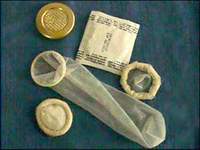Condom appeared after global epidemic of syphilis
There is a large variety of condoms to choose from. The word “condom” has been on everyone’s lips since the early 1980s as an awareness campaign for AIDS gained momentum. On the other hand, the condom as the world’s oldest device used for the purpose of preventing and/or transmission of sexually transmitted diseases (STDs) still gives rise to a lot of questions in terms of its origin.

The discovery of America by Christopher Columbus in 1492 paved the way for a new era. One year later, Columbus and his crews returned to Barcelona from the West Indies. The Spanish court paid great homage to Columbus and his men. However, not only gold and spices arrived aboard his ships. Horrifying rumors about a mysterious disease spread by seamen and soldiers began to circulate through Europe shortly after the return of Columbus’ ships. Syphilis, an incurable disease at the time, quickly began to take its deadly toll of the populations in Europe, India and China. Syphilis was cynically dubbed “the present from the New World” or the “aborigines’ revenge.” An epidemic of syphilis reached an unprecedented scale. Gabrielle Fallopius, an Italian physician and anatomist of the 16th century, authored one of first-known published descriptions of a condom used for disease prevention. He recommended using cloth sheaths soaked in a chemical solution. The sheaths should be allowed to dry prior to use for STDs prevention.
The most likely origin of the word “condom” comes from the Latin condon, which means “receptacle” in English. However, other explanations are aplenty. Some theories maintain that the word is derived from a purported “Dr. Condom” or “Quondam” who was employed at the court of King Charles II of England. The doctor is believed to have manufactured devices for the lascivious king. There is no reliable evidence showing that “Dr. Condom” was a real historical figure.
Most modern condoms are made of latex or polyurethane. Condoms can also be made from one of the oldest materials used for the purpose, namely lambskin, which is made from lamb intestines. In recent decades, condoms have become available in a wide range of colors, shapes and thicknesses. Some stimulating properties which are sometimes added to the condom design include enlarged tips, ribbing or studs.
Condoms can be used as an effective means of preventing STDs (syphilis, gonorrhea, Chlamydiosis, hepatitis B, human papilloma virus, and HIV/AIDS). The method is also used in preventing pregnancy. Not unlike all other forms of contraception, the method cannot give the user a 100% guarantee against unwanted pregnancy though the effectiveness of condoms, if the latter are used correctly and consistently by couples for birth control, is quite high.
It is worthy of notice that a manufacturing technique for condoms has remained largely the same over the last 50 years. A cylindrical glass mold is dipped into a container filled with liquid latex and heated. Condoms are rinsed once they take a proper shape. Vulcanizing agents, stabilizers and other components are added later to improve elastic properties and tensile strength. Condoms are lubricated, rolled up and packaged at a final stage of the manufacture. Condoms are tested for holes with an electrical current. Batches of condoms are also selectively tested for breakage with pressurized air inflation tests.
Translated by Guerman Grachev
Pravda.ru
Subscribe to Pravda.Ru Telegram channel, Facebook, RSS!


